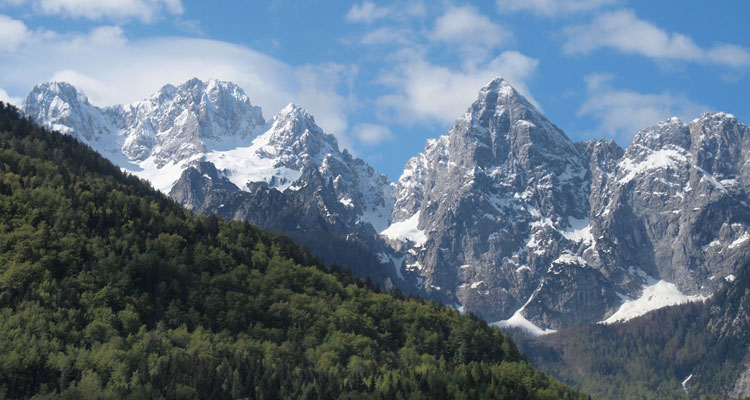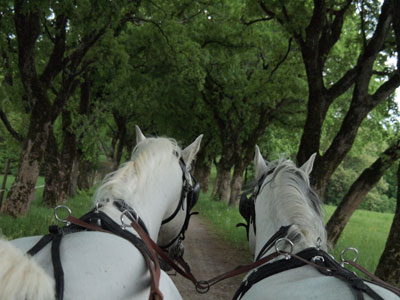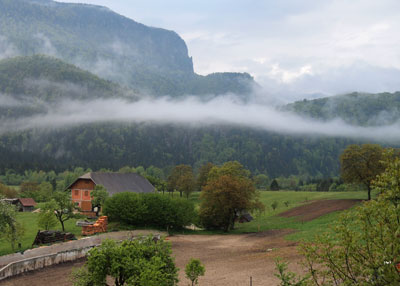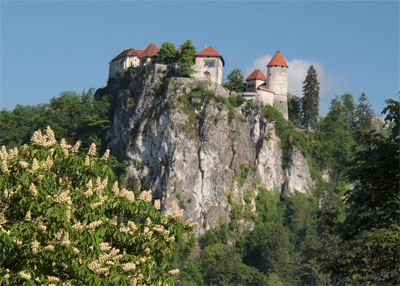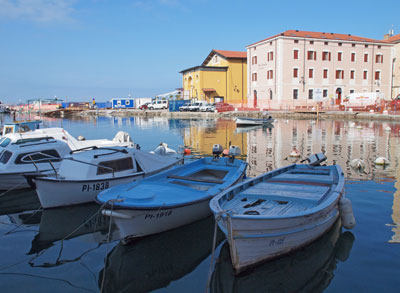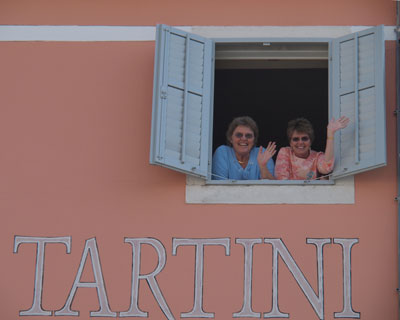Slovenia — discovering this tiny treasure
by Donna Judd; Fullerton, CA
Not to be confused with Slovakia, Slovenia is one of six countries formed out of the breakup of Yugoslavia in the early 1990s. A microcosm of all the best features of Europe, Slovenia packs within its borders castles, vineyards, caves, quaint medieval towns, the Julian Alps and 29 miles of coastline.
Starting out
After an outstanding Swan Hellenic cruise from Athens to Istanbul, my sister, Jody Nyvall, and I arrived in Slovenia’s capital, Ljubljana, on April 27, 2011, National Resistance Day.
After checking in at the centrally located City Hotel, we wandered over to Old Town, listened to a group singing songs of the Resistance and visited with an elderly gentleman who was standing proudly in uniform. With the help of our guide, Luka Esenko, we learned that, as an eight-year-old, the man had smuggled information and medical supplies for the Resistance.
Ljubljana’s pedestrian-only Old Town is quite photogenic, providing opportunities to see the dragons that are symbolic of the city; the meandering Ljubljanica River, with its drooping trees; atmospheric outdoor cafés and outdoor markets, and buildings done in Secessionist style.
We returned to our hotel with the intention of getting in a brief nap before heading out for dinner but, instead, slept until 6:30 a.m. — 13 hours!
We headed downstairs to breakfast, where choices included eggs, sausages and crêpes (with chocolate sauce), in addition to less-familiar selections such as fried vegetable balls, minced pickle, fried cheese and tomato sauce with red peppers, plus a dozen different breads, cookies and cakes.
Although our room was small, as is typical of many European hotels, it was newly renovated and included free WiFi access.
Focusing on photography
That morning, we were off for a day of adventure with Luka, the 31-year-old co-owner of Adriatic2Alps (phone 386 41 561 020), a travel-and-photography business that I discovered on the Internet. A definite find, Luka speaks seven languages and is highly knowledgeable about all the former Yugoslavian countries.
This award-winning photographer leads photography-specific tours — the type we chose — as well as lower-priced conventional tours. Our six and a half days with Luka turned out to be the best photography experience of my life.
The tour cost about $4,000 for two people, with Luka as our private guide, photography expert and van driver. The price included six nights’ lodging, daily breakfast, two dinners and some entry fees.
We tried cave photography at Planina Cave (€25, or $35, for a two-hour tour), located in the karst region outside the capital. The result of water’s action on porous limestone, these karst formations contain Slovenia’s more than 9,000 caves, including the more popular Škocjan Caves, a UNESCO World Heritage Site, and Postojna Cave, which has a miniature railroad that takes visitors 4½ miles in and offers a spectacular 1½-mile hike out.
We chose Planina for the photography opportunities provided by an empty cave and were thrilled with the results. It worked perfectly for our needs, but most people prefer one of the other caves. Bring your jacket!
For a late lunch, we stopped at one of the many, many pizzerias in Slovenia. This one offered 50 choices for pizza, in addition to local specialties such as bull testicles, brains and frog legs. We passed on these “delicacies” and ordered a basic ham pizza (€11). The “small” was the size of an American large pizza, and it included tomato sauce, cheese, olives and ham — not cooked but dried — with a fried egg on top, a reminder that when we travel, even the most familiar food can have a touch of the unusual.
After a drive through Triglav National Park in its spring beauty, we headed home to Ljubljana.
Enjoyable experiences
The next day we left Ljubljana early and headed for delightful Škofja Loka, the best preserved medieval city in Slovenia. Despite rain, I enjoyed photographing the city, as the wet cobblestone streets reflected the colorful buildings on either side.
Next came a reprieve from the rain with our stop in the excellent museum located in Škofja Loka Castle (entry, €4). Established by a Roman Catholic bishop in the 13th century, the castle was rebuilt after being demolished by an earthquake in 1511. The museum covered all the standard items of life — furniture, jewelry, tools, etc. — plus some surprises, such as stuffed animals from the region.
After a stop in Bled for a piece of its famous cream cake (€2), the next order of business was scouting beautiful Lake Bled, its castle and its island for the next day’s photo excursion.
That night we slept at a delightful farmhouse in the countryside. Located 15 minutes’ walk from the lake, Kmetija Mulej farmhouse also provided a delicious dinner of soup, salad, buckwheat with mushrooms, pork chops and apple strudel. Co-owner Damjana Mulej doesn’t speak much English, but she is an excellent cook with a friendly, dimpled smile.
The next morning we headed first to Lake Bohinj, located entirely within Triglav National Park and, thus, much less touristy than Lake Bled. A quiet, electric-powered boat (€10) took us on a most enjoyable hour-long trip that included clouded views of Mt. Vogel and its famous cable car.
Luckily, Lake Bled is at a lower elevation, and the sun came peeking through as we drove along its shoreline. Consequently, we made a beeline to the 11th-century Bled Castle (entry, €7).
A steep walk to the castle and up the stairs within was well worth the climb, as we were rewarded with stunning views of the lake and its tiny island and church. We didn’t tour the castle but simply enjoyed its views.
In Radovljica, six miles south of Bled on Highway E61, we ate a very late lunch at a wonderful restaurant/inn, Gostilna Lectar (Linhartov trg 2, phone 04 537 4800). The food was outstanding — I had a spicy pumpkin soup and a stuffed pepper dish — and the owner entertained us with harmonica and accordion playing of great skill.
The family-owned restaurant is located in a 500-year-old house, which also contains a gingerbread museum, gingerbread having been the family’s specialty for centuries.
Later we wandered Radovljica’s medieval marketplace, enjoyed watching a wedding party, photographed an old church and soaked up more sun. After returning to our farmhouse, it was time for a late nap and an excellent dinner — pretty much a perfect day.
Dramatic displays
We woke to glorious sun streaming through the mist in the valley below our farmhouse window, so we headed back to Lake Bled to again photograph the island before driving through the Sava River Valley and over the Julian Alps to the beautiful Socˇa River Valley. The mountain pass road, originally built by Russian WWI prisoners of war, twisted and twirled through 25 hairpin turns up the mountain, with another 25 on the descent — beauty and excitement combined.
Our next stop was the home of the famous Lipizzaner horses, the state-run Lipica Stud Farm, a beautiful setting of rolling green hills currently hosting 360 horses. After another late lunch, we began our carriage ride.
Halfway through the pleasant, sunny ride we heard thunder, which was followed 10 minutes later by rain. The horses headed for shelter, as did we, but not before getting hailed on. As someone used to sunny Southern California weather, I found this quite an impressive weather display, and all in less than one hour!
Carriage rides cost €40 ($57) for one hour or €20 for a half hour, which is really all you need. The horse show, which we missed, cost €17.
By late afternoon, we arrived at the beautiful coastline resort of Piran, a medieval Venetian walled town, for a two-night stay. Our hotel, Hotel Tartini, was fabulously located right between the Old Town square and a small inlet bobbing with tiny sailboats. Ask for room 301 for a wonderful view of the town square. (Be aware that the cathedral bells begin ringing early and continue to do so every 15 minutes.)
The tiny town is “pedestrians only,” adding to its loveliness.
On our final day, we visited the Roman ruins in Pula, Croatia, then picked up a rental car at the airport. Jody and I were excited about exploring Croatia on our own, but we agreed it was going to be difficult to top the week we had just had with Luka in Slovenia.
Planning a trip
No visa is needed for Slovenia.
July and August are the busiest times for tourism, especially for Italian tourists, with May, June and September offering good weather and fewer crowds. Regardless of the month, Slovenia is never as crowded as neighboring Croatia.
English is taught in the schools, and the people we encountered were friendly. Roads are excellent.
Slovenia uses the euro, and prices are not particularly cheap, but at least you can keep gas costs down since the country is so compact.

